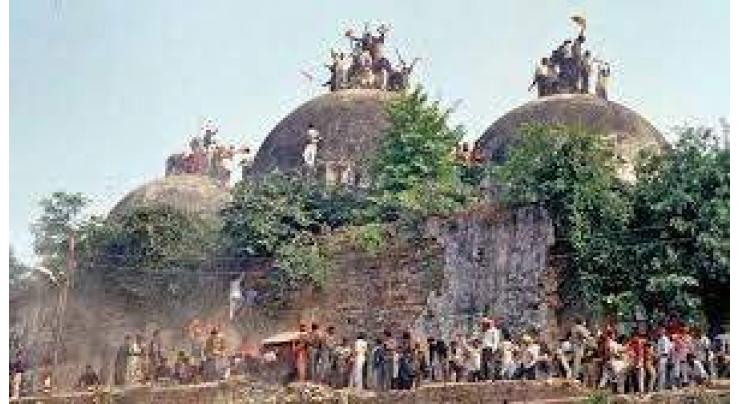
Key Dates In Centuries-old Indian Holy Site Dispute
Umer Jamshaid Published November 09, 2019 | 11:30 AM

The 1992 demolition of Babri Masjid -- a mosque named after the Mughal emperor Babur -- by Hindu hardliners in the Indian holy city of Ayodhya led to riots that left more than 2,000 dead.
Ayodhya, India, Nov 9 (APP - UrduPoint / Pakistan Point News - 9th Nov, 2019 ) :The 1992 demolition of Babri Masjid -- a mosque named after the Mughal emperor Babur -- by Hindu hardliners in the Indian holy city of Ayodhya led to riots that left more than 2,000 dead.
Hindus say the small patch of land where it stood is the birthplace of their revered god Ram, and the site has become a symbol of India's Hindu-Muslim divide.
Here are the key dates in the centuries of bitterness leading up to the Indian Supreme Court's much-awaited ruling on Saturday on who should own the site: - 5114 BC - According to devout Hindus, this was when the important warrior deity Lord Ram or Rama, the seventh avatar of Vishnu, is born in Ayodhya in northern India.
- 1528 AD - After more than a year's work, a mosque to honour Babur, who came from what is now Uzbekistan to conquer northern India, is completed. Nearly five centuries later, the derelict site now covered in weeds and the rubble is considered the epicentre of modern Hindu nationalism.
- 1853 - The first recorded sectarian clashes over the mosque erupt after Hindu devotees launch protests saying the mosque was built on the birthplace of Rama. Muslims stage their own march on Ayodhya and about 70 die in clashes.
Two years later, another Muslim march on the city is fought back by British and Hindu troops in clashes that leave up to 700 dead.
- 1934-1949 - The mosque is damaged in a communal riot in 1934 after the killing of a cow, an animal many Hindus consider sacred. But it is soon after the subcontinent's 1947 partition into Hindu-majority India and Muslim-dominated Pakistan that Ayodhya becomes a battleground between the two faiths.
On December 22, 1949, dozens of people break into the mosque and set up idols of the gods Ram and Sita. The next day, thousands of Hindus gather outside believing it was a miracle.
Federal courts order the idols to be removed, but local courts refuse to enforce the action.
- 1986 - Hindu agitation over Ayodhya grows in the 1980s. In 1986, one radical group launches a campaign to gather bricks for a new temple that draws contributions from across India as well as from supporters in the United States, Canada and Europe.
- 1990 - L.K. Advani, then leader of the conservative Bharatiya Janata Party of current Prime Minister Narendra Modi, leads a procession of Hindus demanding the building of a temple on the mosque site. The Indian army blocks the procession and Advani is arrested. Some 30 Hindus are killed in clashes.
- 1992 - On December 6, some 200,000 Hindu activists gather in Ayodhya. Some climb fences surrounding the mosque. "With pick axes, shovels and their bare hands, they destroyed the mosque in a matter of hours," wrote US professor Heather Selma Gregg in her book, "The Path to Salvation: Religious Violence from the Crusades to the Jihad".
The demolition sparks nationwide riots in which 2,000 people die. There are also disturbances in Pakistan and Bangladesh.
- 2002 - In February, a train carrying Hindu activists from Ayodhya prior to the 10th anniversary of the demolition catches fire in Gujarat state -- where Modi is the chief minister -- and almost 60 are killed. Anti-Muslim riots in the state leave more than 2,000 dead.
Gregg says the modern-day violence took on "mythic proportions, symbolizing the fall of India and its people to foreign occupiers and the need for liberation of not only Ayodhya but the entire subcontinent and Hindu people everywhere".
- 2010 - A court in Allahabad orders the mosque site to be divided between three Hindu and Muslim groups. All the parties appeal and the Supreme Court stays the ruling.
Saturday's judgement will decide the cases.
Related Topics
Recent Stories

Currency Rate In Pakistan - Dollar, Euro, Pound, Riyal Rates On 19 April 2024

Today Gold Rate in Pakistan 19 April 2024

Rock-solid Ruud racks up season-leading win in Barcelona

At UN, Iran says it will make Israel 'regret' reprisals

G7 hears calls for 'critical' Ukraine aid

EU seeks to leverage might to confront China, US challenge

5 Customs officials martyred as their vehicle ambushed by terrorists in D I Khan

Pak-New Zealand match called off due to rain

NHA restores traffic on roads affected by recent rains in Balochistan

China to fully support Pakistan's efforts against terrorism: Ambassador Jiang

U.S. envoy calls on Foreign Minister Ishaq Dar

Poland arrests man over suspected plan to kill Zelensky
More Stories From World
-
Duplantis to unleash 'inner' pole vault contest as Olympics beckon
8 minutes ago -
Australia tells citizens to depart Israel, Palestinian territories if 'safe to do so'
17 minutes ago -
Netflix beats expectations on profit and subscribers
27 minutes ago -
US vetoes Palestinian request for full UN membership
27 minutes ago -
Defending champion Swiatek motors into Stuttgart quarter-finals
58 minutes ago -
Netflix beats expectations on profit and subscribers
2 hours ago
-
Ecuador hit by power cuts of up to 13 hours amid drought
2 hours ago -
Israel launches strike against Iran: US media
2 hours ago -
Kenya military chopper crash kills defence chief
2 hours ago -
Oil surges, equities sink as Iran blasts fan MidEast escalation fears
2 hours ago -
Israel launches strike against Iran: US media
2 hours ago -
At G7, Blinken seeks European support for pressure on China
8 hours ago